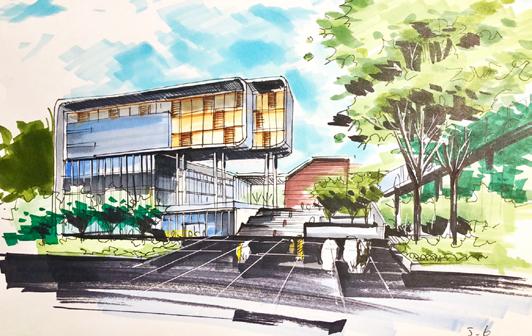

RENHU WU
Tel: +1 (405) 509-1289
Email: wurenhu981022@gmail.com
Website: http://franklinwu.com/
EDUCATION BACKGROUND



Aug.2022 - Now University of Pennsylvania, Philadelphia, Pennsylvania, United States
Master of Science in Design, Robotics and Autonomous Systems(GPA:4.0/4.0)
Sep.2017 - Jun.2022Soochow University (SUDA), Suzhou, China Bachelor of Architecture(GPA:3.7/4.0)
Jul.2019 - Aug.2019 University of California, Berkeley, California, United States Berkeley Summer Sessions (GPA:4.0/4.0)
SCHOLARSHIPS & AWARDS
Oct.2021 The 19th Asian Design School Year Award Excellence Award
May.2020 National Colleges & Universities 3rd Green Building Design Skill Contest Honor Award
Oct.2018 - Oct.2020SUDA Learning Excellence Award
Oct.2018 - Oct.2019 SUDA Consolidated Award
Nov.2018 CAA Art Community Nationwide Design Competition Most Popular Award
Oct.2018 SUDA Merit Student
INTERNSHIP
Jan.2023 - Now
Jul.2021 - Oct.2021
Jul.2020 - Aug.2020 & Jul.2019 - Aug.2019
Research Assistant, University of Pennsylvania Autonomous Manufacturing Lab

Design Assistant, Suzhou Suda Architectural Planning Design Co, ltd Architectural Design No. 1 Studio

Design Assistant, Jiangsu City Construction School Architectural Planning Design Institute

Location:
Year:
Instructor:
Description:
Xincheng Community Centre
Child-centered community relationships

Suzhou, China
2021
Shuo Feng, Guosheng ChenIndividual Work
The high cost of raising kids, a lack of nursery facilities, and the imbalance between childcare duties and career development are among the main factors that prevent couples in China from having children. In addressing these problems, this design is meant to establish a child-centered neighborhood relationship.
Besides, the contemporary city design is not child-friendly. Children are overprotected and isolated from real life. Instead, they should take active parts in urban life. They can learn from observation and receive guidance from the community. This also does help to reduce the burden on the parents.

Population Crisis in China
Contrary to the rapid economy growth in last dacades, the population growth of China is gradually decreasing. It seems that China is following in the footsteps of Japan and other developed countries that are suffering from population decline.
Site Analysis


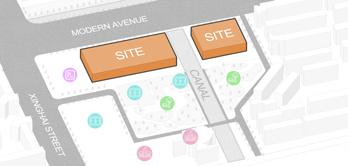
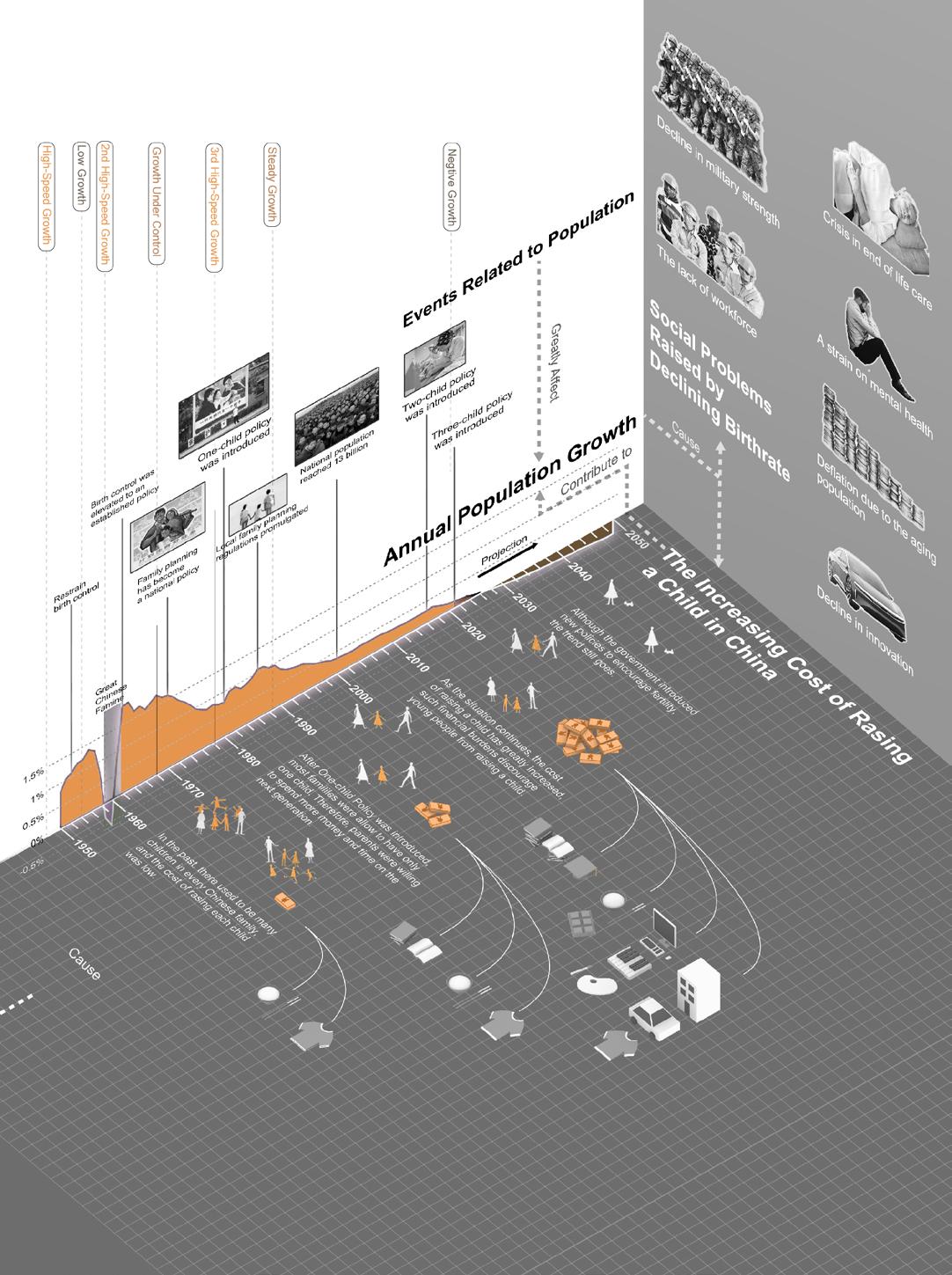
The site is located in Suzhou Industrial Park(SIP), which is one of the China National High-Tech Industrial Development Zone, containing a considerable number of hi-tech companies and bustling commercial center.






Although people living here receive a generous salary on average, many of them, especially young couples, have to pay a lot for the mortgages due to the high housing price here.

People's Concerns
I'm afraid that having a child will compromise my current lifestyle.
Young Couples
Raising a child is so costly nowadays. We'd better earn enough money first.

Population Development
I want to learn drawing. But my parents forced me to take math courses.

Space Strategy
Design Procedure

Generate the basic volumes according to the property lines. Retranct







Split the volumes according to the flow of people.

Axon View






In this child-centered community center, children are observers and participants. They should be present everywhere, which allows them to interact with different environments.
Using the multi-agent system aims to simulate their trails and figure out an organic way to interact with the built environment.





Agent Settings (Boid)
Attraction
Agents will be attracted to the targets scattered in the buildings.
Velocity Matching
Agents attempt to match velocity with nearby flockmates
Attraction Strength
Attracting Radius
Flock centering
Each agent attempts to stay close to nearby flockmates;
Collision Avoidance
Each agent avoids collisions with nearby flockmates

Wandering Wandering is a type of random steering which has some long term order.
Trail Searching Radius
Repulsion Radius

Searching Angle
Direction
Stigmergy Agents will chase other agents' trails.
Slide "Forest"Based on the multi-agent system's simulation, volumes are generated according to the trails. These volumes provide children with a place to hold various activities and allow them to interact closely with the real world while still under proper protection.

Rendering


 Chunk
Activity room
Open roof
Chunk
Activity room
Open roof



Location:
Year:
Instructor:
Home of the Stepwell

Religion, life, and epidemic
Dharavi, Mumbai, India
2020
Zhengwei Xia, Hengliang Tang
Partner: Haoxian Wang

Description:
Popularly known as Asia’s largest slum, Dharavi has active economic activities but poor living conditions. Such a problem is even more evident during the epidemic. People here lack proper medical treatment and a clean housing environment because they cannot protect their interests by speaking with a common voice. Therefore, many of them lost their jobs and struggled to live.
Besides, most residents here have their religious beliefs. Unfortunately they cannot fulfill their rituals because large assemblies are forbidden during the epidemic.
Concept
Based on the local features and slums dwellers' material and spiritual needs, the goal of this design is to improve their current life, maintain their rituals and make the community adaptive to the epidemic.





Lifestyle Analysis
Religious behavior sequence

Pious

Dwellers in Dharavi





Life production
Low shanty towns
Recite Scriptures
Individual Public Group
Private
Living Scaffolding
Large-scale cultural events





Group praying
Playground
Holi Festival
Roof
Commercial Industry

Stepwell: Adaptation Space Transformation







The stepwell is considered an essential monumental structure beyond its functional purpose of the source of water supply.
Besides, people can use it during the dry or rainy season, which shows adaptability due to its vertical stratification.

 Commercial Shop
Diwali
Demostration
Bidet
Bath
Pray
ARATI
Commercial Shop
Diwali
Demostration
Bidet
Bath
Pray
ARATI
Space Strategy
Set the center of "stepwell". Split the site by traffic flow. The courtyards. Rectraction for public space. Connections and Platforms. Vertical transportation.







Site Plan

Activity Analysis
Religious Living Community Commercial Production Anti-epidemic
Religious Living Community Commercial Production Anti-epidemic
Behaviors type
Behaviors type
Use time Policies during the pandemic
Religious Living Community Commercial Production Anti-epidemic
Public Space
The basement floor is used for production and storage activities, serving for the stores on the ground floor.

Behaviors type
Use time Policies during the pandemic
People in Dharavi use to stay outside their home and communicate with neighbours or do some work in front of their homes.
New dwellers can buy a container home. Their homes can be installed on the structure by using the tower cranes.

Dewellers can plant vegetables, dry clothes, play, and do some manual work here.
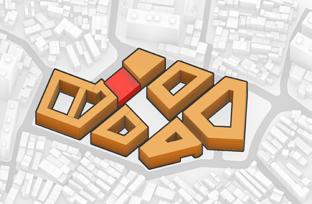
Explosive View
In this design, the central plaza is the buttom of the "stepwell". It shares similar spatial sequence with the traditional indian stepwell, arousing residents' emotional resonance.
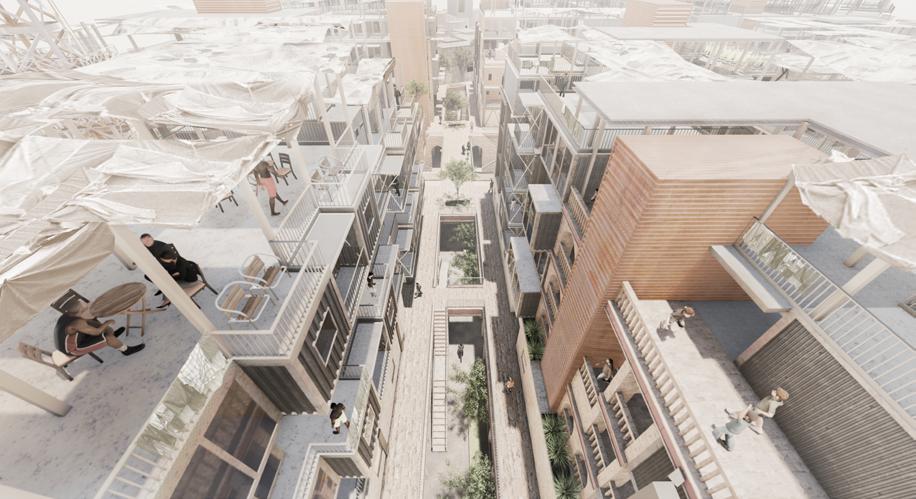



Roof
Canopy
Fixed roof
Above
Stairs
The 'temple'
Container home
First Floor
The 'temple'
Stairs
School
Rendering
Ground Floor
The 'temple'
Courtyard
Playground
Retail store
Tower crane Open plantform Community service Production areaContainer Home





Family members: one pair of parents, three children

Containers used: 6m*2.1m*2.7m*2
Decoration elements

Originated from Hinduism
Family members: one pair of parents, two teenagers, four children


Containers used: 6m*2.1m*2.7m*1, 12m*2.1m*2.7m*2
Section A-A


Location:
Year:
Instructor:
Partners:
Description:
Reindustry Center

The renaissance of automotive industry
Detroit, United States
2021
In this context, we predict boldly that the model of internal-centralized production will regain its importance in the near future. The Detroit, which was trying hard to return to its roots as a vibrant city center in the past decades, was emptied the streets again by pandemic.
Therefore, we decide to propose our skyscraper design solution in the motor city Detroit, aiming to revive the development and transformation of traditional industrial cities.
 Guosheng Chen
Yifei Fan, Wenxuan Tang, Yiyue Su
Guosheng Chen
Yifei Fan, Wenxuan Tang, Yiyue Su
Due to the pandemic, the industrial globalization was impacted heavily. However, the current situation provides an opportunity for those industrial cities which declined under globalization to revive again. In terms of production, the pandemic will certainly not terminate the industrial globalization, but it will help transform the globalization into a new form, a form of regional, limited globalization. Strikes and lockouts happening all around world right now reminds every country that it is important to have its own industrial chain.


During this crisis, however, Tesla, a new giant of car industry emerged. Apart from its main service of electric vehicles showing its concern on the environment, the key factor that contribute Tesla's being a game changer is the Tesla Gigafactory, which is designed to be a net zero energy factory and one of the largest building on earth. The Gigafactory include not only the assembly line, but also the production of batteries and electricity generation. In the Gigafactory, the designing apartment work closely with the producing apartment, which make it easier for new technoloy to put in to use and get the feedback in the first moment. All of these could are good examples for the traditional car makers to imitate.
As one of the biggest cities in the United States, Detroit was the symbol and prize of American industry. However, due to the decline of the motor industry, the factories were discarded, and the population declined rapidly downtown. The once prosperous city was filled with violent crimes, a high unemployment rate and a severe financial crisis. The pandemic made people try so hard to change back to the original point.


Industrial chain process

Considering the current situation, we propose to establish a vertical factory in the form of skyscrapers, which allows for a complete production chain of the automobile. The skyscraper is armed with energy production, raw material transportation, product development, production and assembly, performance testing, tourist etc.



In terms of the design, we decide to revive the famous high-tech style after combing the historical facers and industrial background of Detroit. The goal is to change the current situation of the city by emphasizing on the development of science and technology, as well as making it regain its confidence.

The newest fusion generator on the roof will provide clean energy for the operation for the whole skyscraper. The production workshops in the center each have their own responsibilities to produce assembly component for the assembly line.

On both sides of the tower are office area for staff. The side-building also serves the function of transporting people to different higher platform.
The assembled car will be temporarily stored in the cylindrical parking area at the bottom, waiting to be tested and sold.

The main body of the building with the spiral conveyor belt around makes all the steps of production and the assembly more efficient.




At the bottom is a user experience center where the public interact with the product. People can see the testing and professional equipment of the cars. Moreover, they can complete test drive experience on the outdoor runway directly.

Location:
Year:
Instructor:
Description:

Suzhou Art Museum
Modern transformaion of tradition building style
Suzhou, China 2020
Guosheng Chen, Zhengwei Xia
Individual Work
Suzhou is a city with profound cultural deposits, including classical gardens, ancient buildings and old streets. And the site is located in Suzhou Industrial Area that has been developing rapidly since 1994.
Next to the site is the Xietang Old Street, a famous antique commercial street that attracts visitors from all over the city. The art museum is designed to respond to the history of the site and combine it with the modern way of design.

Site Analysis

GARDEN
RESIDENTIAL
MUSEUM
XIETANGRIVERHISTORICDISTRICT BIKE PARKING
Space Strategy
Functional arrangement
The museum is located next to the historic district, offering parking lots for this area. The garden plays a transitional role.
RESIDENTIAL
XIETANGRIVERHISTORICDISTRICT
Auxiliary area
The auxiliary area half-encloses the visiting area, allowing more connections.
Main exhibition

The main exhibition room is a spirling linear space. Visitors can enjoy the view of the river and the historic district at the end.
Temporary exhibition
The temporary exhibition room is the reverse extension of the main exibition room, which is semi-underground.
Space optimization
Smooth the surface for the entrance and extrude new volume, a slope, connect the exit of the main exhibition room and the ground level.
The lecture hall
The volume of the lecture hall is extruded near the starting point of the main exhibition. Its roof can be used as a garden for the visitors.
THE SITE is located in Soochow Industrial Area that has been developing rapidly since 1994. Soochow is a city with profound cultural deposits. There are many classical gardens and ancient buildings here.
SURROUNDING the site is Xietang Old Street, which has a history of more than 760 years and has been rebuilt several times. Nowadays, it is an antique commercial street that has been completely rebuilt in the past few years.
THE CONCEPT
The exhibition space is spirling linear space, which reminds the visitors of traditional scroll painting. They can enjoy the art work and the view of Xietang Old Street at the same time.
The new buildings are incompatible with the old street.







Space Evolution
Through addition, overlapping, reduction, and separation, the intersection of two linear spaces, one spirling and one semicircular, generates multiple space types.



We do not want our life to be disturbed by tourists.
Methods
Addition Overlapping






It takes hours to come here.
It is enjoyable to sit by the river.
I feel like I was in a traditional chinese painting.
Prototypes Combination
Exhibition rooms Exhibition rooms Gathering space Exhibition rooms Office rooms






Floor Plan




Explosive View
SECOND FLOOR
GROUND FLOOR



BASEMENT FLOOR

Temporary
The Art Museum creates different exhibition spaces. Through penetration and dislocation of different kinds of space, the design breaks the isolation of different rooms. The whole museum is covered by the roof, which inherits traditional Chinese roofs' basic form and structure but differs from that in material and building techniques. So the new roof can be more stable and versatile to provide more possibilities to the space under the roof.


Internal Courtyard



Details

Location:
Year:
Instructor:
Description:
SUDA Gymnasium
Tensile membrane structure

Suzhou, China
2021
The gymnasium is designed for students at Soochow University. In this design, I used the tensile membrane structure to create a natural and organic environment that benefits students physically and mentally.
Apart from holding large sports events, this gymnasium can also be used by every student for everyday exercise and club activities. The running track on the second floor is open to students and also stabilises the whole structure.
 Biao Wang, Hengliang Tang Individual Work
Biao Wang, Hengliang Tang Individual Work
Function Analysis Flow Analysis
Structure Analysis



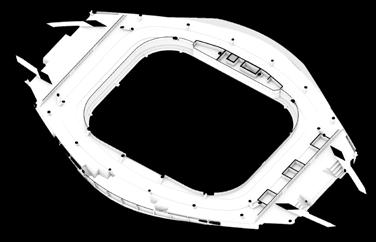







Ground Floor Plan

Second Floor Plan
Interior Rendering

Construction Details
Basement Plan
Manual Model


Other Works










Drawings
